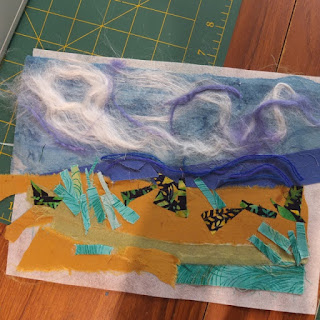Anyway, back to my stream of thought, after that rather large interruption.
Our last one was due last Saturday but I still only had the idea. That idea has been rattling around in my head for ages! I even went so far as to print some fabrics. It was when I was in the doldrums a bit and thought that I should be doing something.
So I got out two stamps I had - one on the soft cut stuff, which was a raised image. The other was cut into lino and gave the other sort of image (can only think of 'not-raised').
I had thought about fossils being buried in layers, so decided that I might play around with layering various fabrics and cutting back to them, using the image I have used a few times, of an ammonite. Also called reverse appliqué.
I used black fabric as the background, so I could cut back to that to represent the holes you often see in these fossils.
I have also been doing a little bit of reading about fossils and some of them become opalised. So I thought I would like to put in some colours that might indicate this - and be more interesting than the browns I kept seeing.
 |
| Work in progress, doing some of the cutting out. Not enough contrast, I thought. |
 |
| The daylight caused the photo to look very different. |
One of the fun things was that I used a multicoloured fabric and it was always a surprise what colour would appear.
I am not 100% happy with the outcome, the image doesn't leap out at me, but it is ok. And it is done. And I have learnt from it.
One thing I learnt, or reminded myself of, is that you need to do more than one line of sewing where you are going to do the cutout. The fabric just pulls out if you only use one, you need two to anchor it.
Also, you can't see the various layers all that well, especially that they have other fossil shapes printed on them. No matter, I know that there are other fossils buried in there.







































